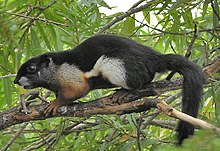| Image |
Scientific name |
Common name |
Description |
Distribution
|
|
Callosciurus quinquestriatus |
Anderson's squirrel |
Made up of two subspecies, C. q. quinqestriatus and C. q. imarius.[5] This species is listed as "Near Threatened" by the IUCN due to habitat loss.[6] |
China and Myanmar
|
|
Callosciurus nigrovittatus |
Black-striped squirrel |
This taxon consists of four subspecies: C. n. nigrovittatus, C. n. bilimitatus, C. n. bocki, and C. n. klossi.[5] It is listed as "Near Threatened" by the IUCN.[7] |
Java, Sumatra, southern Thailand, the Malay Peninsula, and numerous small islands
|
 |
Callosciurus orestes |
Borneo black-banded squirrel |
Listed as "Least Concern" by the IUCN.[8] |
Endemic to northern Borneo
|
 |
Callosciurus adamsi |
Ear-spot squirrel |
Listed as "Vulnerable" by the IUCN.[1][9] |
northern Borneo
|
 |
Callosciurus finlaysonii, misspelled C. finlaysoni |
Finlayson's squirrel, variable squirrel |
|
Cambodia, Laos, Myanmar, Thailand, and Vietnam.
|
 |
Callosciurus caniceps |
Grey-bellied squirrel |
consist of six subspecies found in forests, plantations and gardens |
Peninsular Malaysia, Thailand, southern Myanmar, southern China (Yunnan) and possibly western Laos.[10]
|
|
Callosciurus honkhoaiensis |
Hon Khoai squirrel |
First described in 2018, it is a dwarf species related to the grey-bellied squirrel, from which it probably diverged during the Pliocene.[11] |
found only on Hon Khoai island off the southern tip of Vietnam
|
|
Callosciurus inornatus |
Inornate squirrel |
This squirrel was once considered a subspecies of Callosciurus pygerythrus, and as a result several texts inaccurately cite C. pygerythrus as being found in these areas.[12] The reclassification was based on different fur characteristics, placing it closer in relation to C. caniceps.[12][13] It is listed as "Least Concern" by IUCN.[12] |
distributed across Laos, Vietnam, and the Chinese province of Yunnan.
|
 |
Callosciurus pygerythrus |
Irrawaddy squirrel |
Made up of seven subspecies |
found throughout Bangladesh, China, India, Myanmar, and Nepal.[5][14]
|
|
Callosciurus baluensis |
Kinabalu squirrel |
Its tail and upperparts are grizzled blackish, the underparts are reddish-orange, and the flanks have a narrow buff stripe with a broader black stripe below.[3] This species is listed as "Least Concern" by the IUCN.[15] |
endemic to northeastern Borneo, specifically the wide area around Mount Kinabalu.[1]
|
|
Callosciurus albescens |
Kloss's squirrel |
population data is insufficient to assess its endangerment status according to the IUCN.[1][16] It is debated whether it is a subspecies of C. notatus, which would make Kloss's squirrel instead be named C. notatus albescens. |
endemic to northern Sumatra
|
|
Callosciurus melanogaster |
Mentawai squirrel |
It is further dived into three subspecies: C. m. melanogaster, C. m. mentawi, and C. m. atratus.[5] This small isolated population is listed as "Vulnerable" by the IUCN due to habitat loss.[17] |
native to the Mentawai Islands off the west coast of Sumatra
|
|
Callosciurus phayrei |
Phayre's squirrel |
listed as "Least Concern" by the IUCN.[1][18] |
found in China and southern Myanmar
|
 |
Callosciurus notatus |
Plantain squirrel |
found in a wide range of habitats: forests, mangroves, parks, gardens, agricultural areas |
Indonesia, Malaysia, Singapore and Thailand
|
 |
Callosciurus prevostii |
Prevost's squirrel, Asian tri-colored squirrel |
|
forest in the Thai-Malay Peninsula, Sumatra, Borneo and nearby smaller islands, with an introduced population in northern Sulawesi.
|
 |
Callosciurus erythraeus |
Pallas's squirrel, red-bellied tree squirrel |
|
Greater China, India, and Southeast Asia.
|











